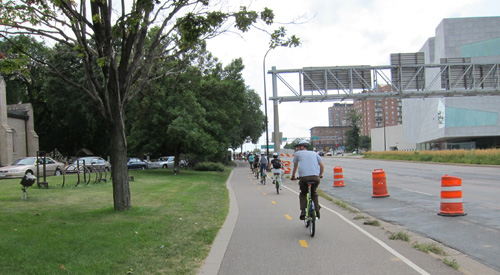Only 11 cities in the U.S. have earned the title of Gold-Level Bicycle Friendly Community from the League of American Bicyclists. In May, Minneapolis joined the select ranks and, last week, the city got a chance to show off its bike progress to a national audience of active transportation advocates and officials.
When Mayor R.T. Rybak took the stage at the Safe Routes to School National Conference, he made it clear that Minneapolis is gunning for Portland, aiming to be the best biking city in the nation. Not surprisingly, many of the 600 attendees were eager to see the anatomy of a gold-level bicycle friendly city firsthand.
The city’s rise is thanks, in part, to the Non-Motorized Transportation Pilot Project, a program created by the last federal transportation bill that put $25 million in the coffers of four cities to increase bicycling through infrastructure improvements. To showcase the innovations spurred by those dollars, in Minneapolis, Shaun Murphy, the city’s non-motorized transportation coordinator, and Steve Clark, walking and bicycling program manager for Transit for Livable Communities, took Safe Routes participants on a bike tour of some of the completed and in-progress projects.
Drawing largely from Clark’s cheat sheet, here are the “10 Design Solutions that Can Transform your City.”
- Bike Sharing System: The Nice Ride bike sharing system has documented more than 215,000 trips since its inception just one year ago. According to rider surveys, 20 percent of these trips replaced car travel and 23 percent of subscribers do not own a bicycle.
- Colorized and priority bike lanes: Shared bike lanes, or sharrows, aren’t nearly as effective as bike lanes in encouraging cycling. But, when painted on a green field, sharrows magically become “priority bike lanes” and boost both the numbers and confidence of cyclists.
- Buffered bike lanes: Many cyclists prefer riding with a buffer zone protecting them from moving traffic and Minneapolis has installed a cycle track on a major downtown stretch with parked cars serving as the barrier. During peak traffic hours, parking is banned, but the bike lane, with a painted buffer, remains.
- Road diets: Minneapolis has found ways to either reduce the number of travel lanes or trim their width to allow for bike lanes. This includes many four-to-three lane conversions and a two-to-one lane conversation, allowing for a wide bike lane, on 1st Avenue downtown.
- Off-street facilities: Few U.S. cities rival the extensive greenway system in Minneapolis, which includes 84 miles of bike paths through parks, around lakes and, of course, along the old rail line that connects the Twin Cities. The Midtown Greenway alone carries more than 3,000 per day during peak season.
- Bike/walk centers and trail-oriented development: The Midtown Greenway Bike Station, a public/private partnership situated directly on the trail, offers riders a chance to rent a bike, grab a coffee or fix a flat. According to Clark, this is the only bike shop in the country that can only be accessed by bike or on foot -- there’s no car access.
- Ubiquitous bike parking: Minneapolis leads the country in bike parking units per capita and is working toward more covered facilities, given that 30 percent of regular bike commuters continue through the winter.
- Bicycle boulevards: Minneapolis is taking a low-volume, low-speed street and turning it into a popular alternative to a parallel high-volume arterial. Bryant Bike Boulevard has access to the main road, and reverses stop signs so bicyclists aren’t forced to stop at every intersection. The speed humps and low speed limit make the street less appealing to motorists, and once completed Bryant will be painted with gigantic bike symbols twice the size of the typical markings for sharrows or bike lanes.
- Improved crossings: Going hand-in-hand with bicycle boulevards, crossing major streets can be a challenge. So Minneapolis has installed a number of innovations, including planted medians, curb extensions (bump outs), and flashing beacons at a busy street crossing on the Midtown Greenway.
- Advisory bike lanes: Advisory bike lanes are based on the principle of designing the street from the “outside in.” In Minneapolis, East 14th Street gets less than 5,000 cars per day, but there’s not enough room to include a bike lane. The solution? No center stripe and a dashed line for the bike lane. This treatment is becoming common for low-volume streets throughout Europe, proving to be an effective strategy for reducing speeds.






